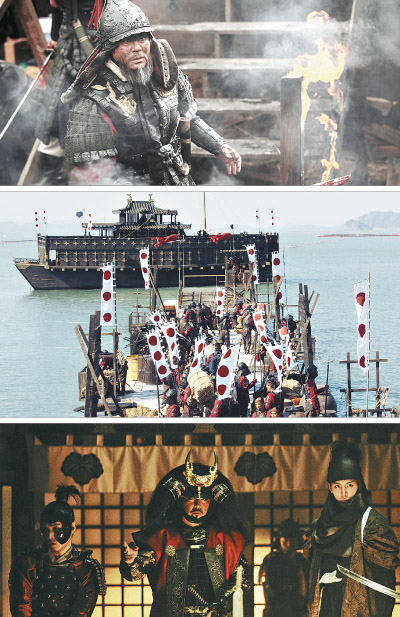[FICTION VS. HISTORY] In the fog of war, some details get lost to history

From top: “The Admiral: Roaring Currents” (2014) features veteran actors including Choi Min-sik, who played Admiral Yi Sun-sin; A scene in the film when Japanese forces storm ahead to attack the Korean naval forces in the waters off the southwestern coast of Korea; Kurushima Michifusa, a top commanding samurai, was played by actor Ryu Seung-ryong, center. [CJ ENTERTAINMENT]
Despite having gone through legal battles for alleged historical distortion, the 2014 historical flick “The Admiral: Roaring Currents” still enjoys the glory of being the most-viewed film ever released in Korea. The movie tells the story of Korea’s most famous naval commander Yi Sun-sin (1545-98) and his fight against the Japanese in the epic sea battle of Myeongnyang in 1597. There were news reports that the film even elevated teenagers’ interest and respect for historical figures.
The film had such an impact in Korea, not to mention other parts of the world where it was released as well, that it doesn’t seem too late to separate the historical film’s facts from fiction. Most of the storyline and the characters stay true to the “Nanjung Ilgi,” or “War Diary,” written by Yi (National Treasure No. 76), which contains drafts of letters and reports about the Imjin War (1592-98). However, because the film was such a big hit, some of the slightest differences raised questions from viewers who saw the film as more of a documentary than a creative work.
The biggest controversy was the way Gen. Bae Seol (1551-99) is depicted in the film. Although Bae is a historical figure, he was portrayed in the film as a villain, stirring up anger among Bae’s descendants. Bae was one of the naval commanders of the Gyeongsang region working for Yi.
In the film, he defies admiral Yi and his plans for the Battle of Myeongnyang. He attempts to murder Yi and sets fire to Yi’s famous Turtle Ship, the single ray of hope for the Joseon naval forces to win their battle against the Japanese who outnumbered them by some 300 ships. Bae is then killed by one of Yi’s men.
Bae’s family has reason to be infuriated, because in reality, Bae did not even participate in the Battle of Myeongnyang in the first place.
Bae is said to have deserted the army just before the Battle of Myeongnyang and was later caught hiding in his hometown of Gumi, North Gyeongsang, and executed. The reason he ran away was because he suffered from seasickness and fear of ocean battles after being defeated by the Japanese during the Battle of Chilcheonnyang in 1597, led by Joseon Admiral Won Kyun.
Bae’s descendants claimed that despite Bae’s contribution to the military - it was Bae who returned from the Battle of Chilcheonnyang with 12 vessels that ultimately became Yi’s only vessels for the Battle of Myeongnyang - his name was sullied in the film. The court, however, ruled in favor of the film’s production team.
Another issue that confused viewers of the movie was the number of Joseon vessels and Japanese vessels. In the film, it clearly states that Korea courageously fought with only 12 vessels and miraculously beat the Japanese forces who charged towards the waters off the southwestern coast of Korea near Jindo with 330 ships.
The number of vessels from both countries is still under much debate as they vary depending on documents. According to Professor Lim Won-bin, director of the Yi Sun-sin Research Institute of Soonchunhyang University, the most widely accepted theory is that Yi had 13 vessels and that there were 133 Japanese ships. In the “Nanjung Ilgi,” it states that 133 Japanese ships were mobilized during the Myeongnyang Battle.
Experts insist that the number in his diary was mistranslated to 330 in 1795 when Korea carried out a project to publish “The Collected Works of Admiral Yi Sun-sin” because Yi’s handwriting was quite illegible.
Meanwhile, Yi’s letter to King Seonjo states that he had 12 ships, but in the Annals of the Joseon Dynasty, it says that Yi fought the battle with 13 ships. Historians believe that Yi had 12 ships before the battle, but probably obtained or built another ship right before the Battle of Myeongnyang began.
The director also probably wanted to feature the imposing Turtle Ship Admiral Yi is known for in the film. The film shows how Bae Seol sets the turtle ship on fire, and towards the end of the movie, the Turtle Ship miraculously appears again to fight the Japanese naval forces.
But during the actual Battle of Myeongnyang, Yi had no turtle ship to fight with because all of the turtle ships had been destroyed in the Battle of Chilcheonnyang, according to historical records.
Many of the characters in the film are based on real historical figures, including Japanese pirate-turned-Admiral Kurushima Michifusa, played by Ryu Seung-ryong. In the film, Admiral Yi heroically finishes him off by cutting his head off during a hand-to hand fight on the deck of Yi’s ship. The truth, however, is that Kurushima did die during a battle, but the details of how are unknown. Moreover, there was no hand-to-hand fight on Yi’s ship, insists Professor Lim, explaining that only Captain Ahn Wi’s ship had such a fight.
There are still many disagreements over where the exact battle took place, but most people seem to agree that it was Yi’s courage and his tactics that allowed Korea to win the Battle of Myeongnyang.
BY YIM SEUNG-HYE [sharon@joongang.co.kr]










with the Korea JoongAng Daily
To write comments, please log in to one of the accounts.
Standards Board Policy (0/250자)